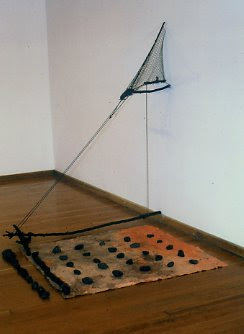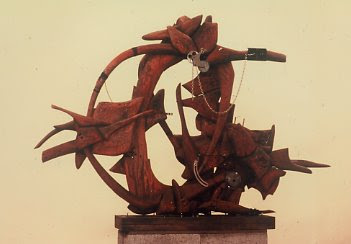ロバート堂園は昔からの私の友人で芸術家の仲間でもあり、日本で言えば私にとって先輩のような存在でもある。 彼も私が最近入ったブラックフィシューギャラリのメンバ・オーナーで、長い間ギャラリーのリーダーとし活動していたようだ。彼のおかげで私はオレゴンの芸術界にスムースに戻った。私だけでなく色んな芸術家たちを手伝っているようで、人派が広い。
画家としてもロバートは優秀で尊敬している存在で、私が日本にいる間ずいぶん腕を上げたよう。この期間、まだ環境問題が世間に大きく注目する以前から彼はエコーグリーンアーチストとして活躍していたようだ。ロバートは魚釣りなどが大好きでよくオレゴンの大自然の中で友人たちと魚釣りをしている。私も数年前オレゴンに夏休みに帰った時、釣りにつれていってもらった。オレゴンの高山の湖でゴムでできたソファのイスの形をした物に一人で乗って足についたフレッパでこきながらフライフェシングーした。面白く、不思議な釣りだ。又、大工の経験のある彼は三十年ほど前に太陽のエネルギーを保存する建築雑誌の記事になるような素晴らしい家も建てた。このように環境に関して強く意識しているロバートはごみを捨てないで自分の作品に使い出した。生ものはもちろん肥料に。使い物を作品に使うのはめずらしくはないが、意識して自分の毎日の使い物を作品に使いそれを長い期間地元の風景画につかうのはけっこう独特。それをしっかりした基本の優れた絵画の技術で完成させると見事な作品にできあがる。風景と色彩だけでなく立体感とテックスチャでも楽しめる作品である。それといくつかのパネルで作り上げた変わった形のパネルと絵の角度の成果、絵を観ているというより、川の流れの中に立って風景を見ているような感じにさせる。この作品のグループは少し、離れて見たほうが全体の雰囲気をあじわえる。前の英語で書いている記事のイメージなどを見ると彼の作品制作方法がだいたいわかるはず。
This blog presents and discusses artist/educator, K. Ikeda's sculptural depiction of a mythological tree, "the Tree of Life", and on works of his students and artist friends
Tuesday, May 26, 2009
Saturday, May 23, 2009
Introducing artist,,Robert Dozono
 Above and Below, "Good Earth, Orignal-Kiss My Face Clackamas#13"
Above and Below, "Good Earth, Orignal-Kiss My Face Clackamas#13"(unfinished above and finished state below)

Robert Dozono is an Eco-Green artist that is he deals with environmental issues in his work. For a long time, Dozono has painted local landscapes on panels pasted with his own recycled garbages. Apparently its his comment on a need to recycle used man made objects to both retain and maintain a beauty of nature. At the same time, for me, these works are beautiful, masterfully painted landscapes with subtle colorings of warm and cool colors and variety of textures created by various shapes of disposed objects. Irregular shape of many of these paintings at times created by combining panels and an angle of pictorial view, I think, help the viewer to enter them as if though a viewer is seeing the flowing river and green forest from standing on currents of water or an invisible rock in the midst of widening river.
Robert is a friend of mine from olden days. I got to know him when we worked on Asian Artist of Oregon exhibition back in early 80's. Back then he was a fine painter of mostly figures and landscapes. Robert began his disposal pieces after I left for Japan so I did not see the very beginning of these works. However, each time I visit Dozono's studio, his disposal paintings seems to gain in depth and presence. Image photos in this page, I don't think, do justice, because photos miss both the subtleties and clarity of the actual work. Clarity is missed because from my experience a person needs to be several feet away from these works to see clearly the realism in them. Also due to various shapes of disposals sticking out from the paint panel, these are more three dimensional than most paintings so that much of physical aspect of the painting is missed in the photos. T
These are powerful group of paintings that were slowly developed over a substantial period of time, and I sure would love to see a major retrospective exhibition of them. (photo images permission granted by the artist).
Tuesday, May 19, 2009
「わな・壁ときしゃぽっぽ」ブラックフィシューギャラリでの二番めの個展・二人展について」 --Japanese version of second Blackfish Gallery Exhibition


昔、 ブラックフィシューギャラリーで開いた個展・二人展の二番目は個展でこのギャラリーで行った中ではもっとも大きくて成功したショーだった。最初の時と同じ く文明・文化についてのコメントだったが、最初のと違いは大昔の文化についてよりも、今回は自分の住んでいた文化についてのコメントだった。このショーで 若いころの私の代表的な彫刻シリーズ「壁」を紹介した。その中でも「壁1」と「壁2」は私の作品の中ではもっとも優れた作品の内に入ると思う。八メートル も長い作品「きしゃぽっぽ」もここで紹介し、今でもこの作品のことを聞かれる。日本からアメリカへ移民したときオレゴン州ポートランド市の「古い町」と今 はポートランドでは銀座のように盛んな地区だったが昔は工場、倉庫と汽車の集まり場だった「パール地区」の間に住んでいた。そこの古いホテルの建物が家が 経営していた建物だった。子供のころからひび割れの壁などを手入れしてペンキ塗ったり、古い家具などニースやステインなどで塗り直ししていた(私の作品に よくステインやニースなどがつかわれるのはこのころからの影響)。そして崩れかけた古い町や倉庫地帯の建物などの中で育った事が記憶にのこり、無意識にこ の個展の作品の形を大きく影響したようだ。「きしゃぽっぽ」や「壁」の作品のレタ-に使われたステンシルを使ってプリント・版画のような平面の作品もいく つかこの個展に展示した。 全体は通り過ぎていく時代にたいして撮りすぎていくノスタルジアのような雰囲気の個展のようだった。 上「きしゃぽっぽの一 部」と平面作品「BC」 Posted by K. Ikeda at 5:30 PM 0 comments
もう一つの作品シリーズを展示したことを言い忘れた。これは「わな」シリーズでこの個展に展示した材木など建築材料で作られた人工的な作品とはちがい、石や木の枝など自然の物と綿でできたネットなど自然と共に生きている人たちの材料をつかって造った作品。又、幾何学的な形の固体とは違い空間的な形の違いもあり、当時何人かから、作品の類が違いすぎるのではないかと批評をあびた。当時は若く、感にまかせ、思いついたものを造って展示していたからその批評にこたえられなかった。あらためて今観ると、どうも幼いころの若いころの二つのまったく違う対照的な生き方の現われのようだ。学校の授業がある時は、町の中心地に住んでいたが、アメリカの長い夏休みには幼いころから小屋に住み、週末までイチゴをつんでいた。それを9年もやった。そのほかボーイスカウトのキャンプなどの経験や幼いころ日本の魚業が盛んな港で育ったことなど、それと大学の寮のルームメイトが野鼠などワナでつかめその皮を売っていた記憶などがこのような作品を造らせた元かもしれない。現在、私の一生の作品テーマ、人間の世界と自然の世界の関係を現す「生命の木」の作品を思うと、すでにこのブラックフィシューぃギャラリーの個展でそのような方向性を表したように見え、なんとなく「わな」の作品を「壁」などの作品と一緒に展示した理由が今になって分かるような気がする。 この時初めて私の作品に現わ
れた枝やひもなどがのち「生命の木」ではもっとも代表的な材料・モチーフになるとは時・創作の流れ面白い。
上「ワナ#3」と展示の風景ー前、「壁4」と後ろ{壁2」; Top" Trap #3" and view of the Blackfish Gallery 1981 with Wall 3 in front and Wall 2 in back.l
TheTrain, The Walls and Traps- the Second Blackfish Exhibition, part II

In addition, I have made five"trap pieces” for this exhibition. These were unlike any of the other pieces in this exhibition in that they were spatial works instead of solid forms with an intricate surface treatment as " the Wall" or ''the Train" pieces. And above all, unlike construction materials used in other works, these were made of branches of a tree, fish net and pebbles- materials close to nature. The experience of born in fishing port in Japan, camping as a member of boyscout in Oregon, interest in a primitive culture, and having a room mate at Oregon State University dorm who was making allowance money trapping and selling muskrat all these probably had something to do with formation of these pieces. There were criticisms that having these "Trap Series" works with "the Walls" and "the Train" in a one show was inconsistent. At the time of the exhibition I wasn't sure about this. Being young and inexperience, I just made what came to me. Reflecting back, "the Traps" simultaneous appearance with "the Walls" and "the Train" does not seem that contradictory in that this reflected dichotomous childhood existence within me: of my experience of living in the midst of city vs. summer country life of living in cabin picking berries and going out for boyscout camping. But more than this, already in this exhibition, signs of my need to show world of mankind simultaneously with world of nature as in my life's work "the Tree of Life " is shown. The "Trap Series" gained much more significance as usage of branches and coils of thread as in these works becomea major elements in my current works.
Above left "Trap #" (左上「わな#4)
TheTrain, The Walls and Traps- the Second Blackfish Exhibition, part I


The second exhibition I had at Blackfish was one person exhibition, and it was the biggest exhibition I had there. The show was continuation of exploration into artifacts of mankind except instead of making sculptures that refer to some ancient cultures, this one contained forms that are derived more from a personal experience. The "wall' pieces probably derived subconsciously from my experience of sanding, painting and staining walls and woodwork of old hotel in the Old Town part of the city where I was raised. In fact the staining and varnishing technique that I use considerably in my work derived from my childhood where I helped out refinishing old furniture. Also living in the edge of Old Town and in the old Pearl district area of city of Portland with warehouses, factories and railroad yards of weathered brick buildings with worn out paints of advertisements on exterior and box carts probably deeply imprinted me. This background then also resulted in the installation piece of this exhibit, "the Train" which may well have been the single, largest work presented in this first Blackfish space. Although wall pieces I thought had some of the most favorable reaction I ever received from the audience, its "the Train" piece people seem to remember the most as I still hear people talking about it even to this day. Stenciling technique I used in the sculptures, I used it also on print/painting in which "BC" is one example. I used exterior latex paint for cement floor which gave an effect similar to worn out paint on exterior walls of old building.
Above, detail of installation, " the Train"(3'x10'x25') 上、「きしゃぽっぽ」 To the right above, print/paint on paper"BC" 右上「BC」
Thursday, May 14, 2009
Humor Break ; an Adventure of Banaman 「バナナマンの冒険」

Bananaman is a character created by 'Dragon' Sasaki as a part of our presentation for the campus festival. My seminar student, Masayo Kawasaki led others to an idea of selling chocolate covered bananas during the Dohto campus festival of 2006. Being a sculpture seminar, Dragon Sasaki decided to create a three dimensional figure to represent our product. The character became very popular and came to be known as "Bananaman". Represented in various ways, here students played around with the character while installing the sculptures for seminar exhibition. To see more of his adventure check the bottom area of the left column. (Photo to the right, Bananaman being chased by Hayashi's Stag Beetle)
バナナマンはゼミ生のドラゴン佐々木が2006年の道都大学学際の時に作ったキャラクタです。この年、聴講生の川崎マサヨによってイケダゼミは学際ではチョコバナナを売ることに決め、彫刻ゼミには立体のキャラクタが必要と思い、佐々木君が作ったものがバナナマンでした。とても人気があり、いろいろな風に遊ばれましたが、ここではゼミ展の時作品を搬入している間、学生たちが遊んでいるものを当時のゼミ長、イックンが撮ったものです。左のコラムの下のあたりにバナナマンの冒険写真が観られます。〈左、林君のクワガタに追いかけられている、バナナマン)
Sunday, May 10, 2009
ブラックフィシュギャラリーの個展・二人展第一回め (On First Blackfish Exhibition-Japanes version)


 Above top, "Cyrus's Lost Invention", Middle top, "Oseberg Imagery, Bottom above, "Boogie Woogie Synthesizer" 上、「発明家サイラスの失われた発明」中;「バイキングの遺跡オセバーグのイメージ」;下、「ブギーウギーシンセサイザー」、それぞれ1980完成
Above top, "Cyrus's Lost Invention", Middle top, "Oseberg Imagery, Bottom above, "Boogie Woogie Synthesizer" 上、「発明家サイラスの失われた発明」中;「バイキングの遺跡オセバーグのイメージ」;下、「ブギーウギーシンセサイザー」、それぞれ1980完成共同ギャラリーブラックフィシューに又メンバーオーナとして入りましたのでこの機会を利用し、再び、最初創立メンバとして入ったころの個展・二人展などを見つめなおしたいと思います。最初の二人展は1980にダイアン・アルカィアとおこなったものです。このころの私は歴史とか文化などに非常に興味を持っていて、この二人展の作品もそれを表していました。それぞれ失われた謎の文明が作った人口遺物のような彫刻を作りました。ルータやドリルで刻み、様々な色のスーティンで古風に表し、金物の部品や縄などで人口敵な味・匂いをだした作品集です。写真はこの展示の時の物ですが、写真が悪いので私のアトリエでとった一つの写真もここに置きます。
On First Blackfish One/Two Person Exhibition:" Artifact Series"



Above top"Portrait of Hachiman" 1980; Above middle, " Windjammer"with Paul playing the guide and Esther looking from the office door; Just above, myself taking photo of the show at the first Blackfish Gallery space in 6th in Flanders.
Becoming a member of Blackfish after twenty six years, I think this isa good time to reflect over the shows I had there. I may learn something in the process. First one/two person exhibition I had there was a group of six large sculpture pieces which I called " scroll" series, but which I now renamed "artifact" series. It seemed that the works that I have done in this period seems to derived a lot from man made objects that as in this group such as "Boogie Woogie Synthesizer", " Windjammer" and "Cyrus's Lost Invention" pieces. With many organically carved lumber woods assembled mixed with various hardwares and cotton cords, the pieces resemble some artifacts of lost civilization to me as well as to other viewers. "Perhaps naming one of the piece, "Oseberg Imagery" after a famous Anglo Saxon site, shows this unconscious tendency to reflect ancient artifact.
The exhibition was held in 1980 with Dianne Alkyire who had pencil and color pencil abstract pattern like works that seem to reflect her interest in color, shades and texture.
Wednesday, May 6, 2009
ブラックフィシュ共同ギャラリーへ入る(joining Blackfish Gallery-Japanese version)

今週からポートランド市へある共同ギャラリーブラックフィシュへメンバーオーナとして入りました。この画廊は今から三十年前の1979年、私と他15名の芸術家たちが創立した共同画廊です。アメリカでは画商のことをコマシャールギャラリーとも呼ぶのでギャラリーと言う言葉は勘違いしやすいと思いますが、このブラックフィシュギャラリーは画商でもあり、管理する人もやとっています。
創立した時は私は大学院から卒業る前でメンバの中ではもっとも若かったですが、ほとんどみんな二十代から四十代の若い芸術家たちでした。地元の大学や美術大学を教えているメンバが多く、その成果、若いながらも責任感もあり、経験豊かで、当時画廊はできてもせいぜい二、三、年間しかもてないころ、三十年も存在できた土台を築いたようです。 創立したころは私はもっとも若いだけでなく、もっとも芸術活動に関しては経験薄く、ブラックフィシュは私にとって先輩たちから学ぶ場所でした。創立したころのメンバたちは今では三人しか残っていないようです。大都会のニューヨーク、シカゴ、ロースアンゼルスなどに移住したメンバもいればこの町に残り他のコマシャールギャラリーに移り活躍している者もいます。何人か美大の偉い先生になっている者もいて当時はそう思っていませんでしたが、今振り向いて見ると結構創立メンバには優秀な芸術家が多くいたんだなと思います。
現在は三十人ほどいて、それぞれ交代で展示しているようです。平均年齢もあがり、二十代から七十代までで年齢の幅は昔とくらべるとずいぶん広いです。創立の時とくらべれば全体のレベルとエネルギーは落ちたように私には感じますが、優れた芸術家はまだ何人かいるようです。メンバになるには審査があり、ある程度のレベルがないと認められないようです。
このギャラリーに新しいエネルギーをあたえなければと思っていますが、ぎゃくにエネルギィーをあたえられるほうかもしれません〈笑い)。このような共同ギャラリーの一つ進めるところはやはり、仲間と共同ですることにより、お互い学べる事が多く、又刺激もあり、創作エネルギーが増加することです。あと普通のコマシャールギャラリーとは違い、売れる作品を意識しながら造る、描く圧力がない事です。この制作自由は私の性格と私の作品にはあっているようです。あともう一つはここのギャラリーのスペースの広さはこの町ではもっとも広いほうで私の彫刻を展示するのには向いているようです。
(下の写真は1983年にブラックフィッシュで展示した「壁」の作品シリーズです。)
Tuesday, May 5, 2009
Rejoining Blackfish Gallery



I have just joined Blackfish Gallery. Its a co-op gallery that I and about 15 other artists founded back in 1979, thirty years ago. I left the gallery in 1983 after four years as I was young and needed more, different experiences. Besides numerous group exhibitions, I had three major one/two person exhibitions there. I say major because these were some of the most ambitious and best shows that I held. After returning from Japan, I have felt that rejoining Blackfish seems like the right thing to do at this point of life.
Why this co-op gallery instead of other commercial galleries, especially now that unlike 1979 there are many fine galleries in Portland? From my previous experience the advantage of this co-op gallery is that members are at the same time co-owners so that there is more freedom to exhibit work than in a regular commercial gallery;that is, there is no one to tell you what type of work he/she wants out of artist for a commercial reason. My work, and my personality I feel demands a good deal of this creative freedom. While artist is allowed considerable freedom at Blackfish, yet the gallery is administered professionally. Also Blackfish as I recall is a place to meet and work with fellow artists so that it becomes a place to communicate, interchange ideas and thoughts, and this interaction creates a great deal of energy.
Though I am not 25 as I was when Blackfish was founded, the gallery also matured as I matured. I hope though to interject as much energy as I did in my youth in coming years at Blackfish. And I hope to add new, spicy flavors to Blackfish that stores of life 's experience that I have gained in these last thirty years will provide.
Above: Wall pieces shown in the exhibition at Blackfish in 1983
Subscribe to:
Posts (Atom)